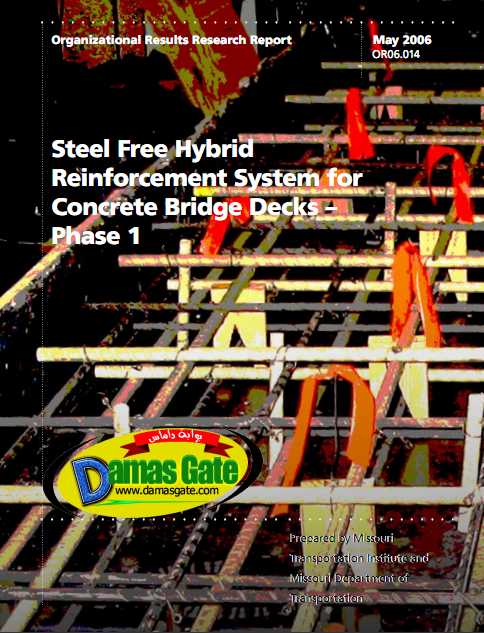Steel Free Hybrid Reinforcement System for Concrete Bridge Decks

ACKNOWLEDGEMENTS
The authors from both the University of Missouri-Columbia (UMC) and the University of Missouri-Rolla (UMR) would like to gratefully acknowledge financial support from the Missouri Department of Transportation (MoDOT) for the research project. UMR researchers would like to additionally acknowledge support from the UMR University Transportation Center.
The Principal Investigators on both campuses are also thankful to Doug Gremmel of Hughes Brothers and Richard Smith, SI Concrete Systems for their participation as well as the generous inkind material donation to this project. Support for the
full-scale slab tests from UMC undergraduate honors students Kendall Tomes and
Sarah Craig are also acknowledged. The authors would also like to thank the
following individuals for numerous discussions during quarterly meetings for the project
: Michele Atkinson, Tim Chojnacki Bryan
Hartnagel, Paul Porter, and Shyam Gupta (all of MoDOT) and Peter Clogson (FHWA).
Early discussions with Prof. Aftab Mufti of ISIS, Canada also helped develop ideas for the project described in this report. These contributions from Prof. Mufti are gratefully acknowledged.
EXECUTIVE SUMMARY
New materials and design methods are being investigated for the design of bridge components to
alleviate the current devastating corrosion problems. A research project was initiated at the University of Missouri (UM) and the Missouri Department of Transportation (MoDOT) to develop a nonferrous hybrid reinforcement system for concrete bridge decks by using continuous fiber-reinforced-polymer (FRP) rebars and discrete randomly distributed polypropylene fibers. This hybrid system may eliminate problems related to corrosion of steel reinforcement while providing requisite strength, stiffness, and desired ductility, which are shortcomings of FRP reinforcement system in reinforced concrete.
The overall study plan includes: (1) development of design procedures for an FRP/FRC hybrid reinforced bridge deck, (2) laboratory studies of static and fatigue bond performances and ductility characteristics of the system, (3) accelerated durability tests of the system, and (4) static and fatigue tests on full-scale hybrid reinforced composite bridge decks.
The test results showed that with the addition of fibers, structural performances of the system are improved. Although polypropylene fibers do not increase the ultimate bond strength, they provide enhanced ductile bond behavior. Also, with the addition of fibers, the flexural behaviors are
improved with the increase of the ductility index µ by approximately 40%, as compared to the plain concrete beams. In addition, with the addition of polypropylene fibers, the durability of the system was improved.
The large-scale slab tests revealed that crack widths were smaller for hybrid slab than for GFRP slab and were more readily comparable to that for steel reinforced slab, even while the global stiffness of the hybrid slab was more comparable to the GRFP slab. Design guidelines for steel-free bridge deck are proposed based on a similar design equations provided by ACI440. These equations were calibrated using the results of the above test program. Contrary to the current design methods, it is recommended that flexural design of deck slabs be carried out using working stress approach with mandatory checks on ultimate capacity and mode of failure. This approach is more practically relevant for hybrid reinforced FRP slabs. The large-scale tests proved that the proposed design guidelines for such hybrid system are adequate and are ready for implementation in the design a hybrid steel-free bridge deck.
Download
http://s18.alxa.net/s18/srvs2/02/002...idge.Decks.rar